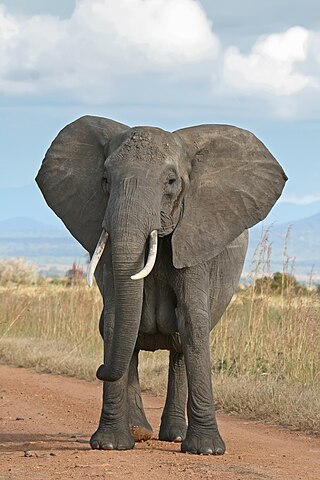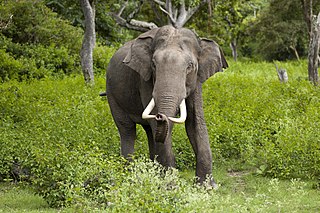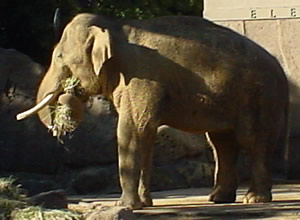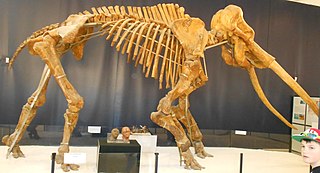
Elephants are the largest living land animals. Three living species are currently recognised: the African bush elephant, the African forest elephant, and the Asian elephant. They are the only surviving members of the family Elephantidae and the order Proboscidea; extinct relatives include mammoths and mastodons. Distinctive features of elephants include a long proboscis called a trunk, tusks, large ear flaps, pillar-like legs, and tough but sensitive grey skin. The trunk is prehensile, bringing food and water to the mouth and grasping objects. Tusks, which are derived from the incisor teeth, serve both as weapons and as tools for moving objects and digging. The large ear flaps assist in maintaining a constant body temperature as well as in communication. African elephants have larger ears and concave backs, whereas Asian elephants have smaller ears and convex or level backs.

A mammoth is any species of the extinct elephantid genus Mammuthus. They lived from the late Miocene epoch into the Holocene until about 4,000 years ago, with mammoth species at various times inhabiting Africa, Europe, Asia, and North America. Mammoths are distinguished from living elephants by their spirally twisted tusks and in at least some later species, the development of numerous adaptions to living in cold environments, including a thick layer of fur.

Homotherium is an extinct genus of scimitar-toothed cat belonging to the extinct subfamily Machairodontinae that inhabited North America, South America, Eurasia, and Africa during the Pliocene and Pleistocene epochs from around 4 million to 12,000 years ago. It was one of the last surviving members of the subfamily alongside the more famous sabertooth Smilodon, to which it was distantly related. It was a large cat, comparable in size to a lion. In comparison to Smilodon, the canines of Homotherium were shorter, and it was probably adapted to running down rather than ambushing prey, and is suggested to have engaged in cooperative hunting.

A mastodon is a member of the genus Mammut, which, strictly defined, was endemic to North America and lived from the late Miocene to the early Holocene. Mastodons belong to the order Proboscidea, the same order as elephants and mammoths. Mammut is the type genus of the extinct family Mammutidae, which diverged from the ancestors of modern elephants at least 27–25 million years ago, during the Oligocene.

Elephantidae is a family of large, herbivorous proboscidean mammals collectively called elephants and mammoths. These are large terrestrial mammals with a snout modified into a trunk and teeth modified into tusks. Most genera and species in the family are extinct. Only two genera, Loxodonta and Elephas, are living.

Elephant birds are extinct flightless birds belonging to the order Aepyornithiformes that were native to the island of Madagascar. They are thought to have become extinct around 1000 AD, likely as a result of human activity. Elephant birds comprised three species, one in the genus Mullerornis, and two in Aepyornis.Aepyornis maximus is possibly the largest bird to have ever lived, with their eggs being the largest known for any amniote. Elephant birds are palaeognaths, and their closest living relatives are kiwi, suggesting that ratites did not diversify by vicariance during the breakup of Gondwana but instead convergently evolved flightlessness from ancestors that dispersed more recently by flying.

Mammutidae is an extinct family of proboscideans belonging to Elephantimorpha. It is best known for the mastodons, which inhabited North America from the Late Miocene until their extinction at beginning of the Holocene, around 11,000 years ago. The earliest fossils of the group are known from the Late Oligocene of Africa, around 24 million years ago, and fossils of the group have also been found across Eurasia. The name "mastodon" derives from Greek, μαστός "nipple" and ὀδούς "tooth", referring to their characteristic teeth.

Elephas is one of two surviving genera in the family of elephants, Elephantidae, with one surviving species, the Asian elephant, Elephas maximus. Several extinct species have been identified as belonging to the genus, extending back to the Pliocene or possibly late Miocene.

Palaeoloxodon is an extinct genus of elephant. The genus originated in Africa during the Early Pleistocene, and expanded into Eurasia at the beginning of the Middle Pleistocene. The genus contains the largest known species of elephants, over 4 metres (13 ft) tall at the shoulders and over 13 tonnes (29,000 lb) in weight, representing among the largest land mammals ever, including the African Palaeoloxodon recki, the European straight-tusked elephant and the South Asian Palaeoloxodon namadicus. P. namadicus has been suggested to be the largest known land mammal by some authors based on extrapolation from fragmentary remains, though these estimates are highly speculative. In contrast, the genus also contains many species of dwarf elephants that evolved via insular dwarfism on islands in the Mediterranean, some like Palaeoloxodon falconeri less than 1 metre (3.3 ft) in shoulder height as fully grown adults, making them the smallest elephants known. The genus has a long and complex taxonomic history, and at various times, it has been considered to belong to Loxodonta or Elephas, but today is usually considered a valid and separate genus in its own right.

African elephants are members of the genus Loxodonta comprising two living elephant species, the African bush elephant and the smaller African forest elephant. Both are social herbivores with grey skin. However, they differ in the size and colour of their tusks as well as the shape and size of their ears and skulls.

The Columbian mammoth is an extinct species of mammoth that inhabited North America from southern Canada to Costa Rica during the Pleistocene epoch. The Columbian mammoth descended from Eurasian steppe mammoths that colonised North America during the Early Pleistocene around 1.5–1.3 million years ago, and later experienced hybridisation with the woolly mammoth lineage. The Columbian mammoth was among the last mammoth species, and the pygmy mammoths evolved from them on the Channel Islands of California. The closest extant relative of the Columbian and other mammoths is the Asian elephant.

The straight-tusked elephant is an extinct species of elephant that inhabited Europe and Western Asia during the Middle and Late Pleistocene. One of the largest known elephant species, mature fully grown bulls on average had a shoulder height of 4 metres (13 ft) and a weight of 13 tonnes (29,000 lb). Straight-tusked elephants likely lived very similarly to modern elephants, with herds of adult females and juveniles and solitary adult males. The species was primarily associated with temperate and Mediterranean woodland and forest habitats, flourishing during interglacial periods, when its range would extend across Europe as far north as Great Britain and eastwards into Russia. Skeletons found in association with stone tools and wooden spears suggest they were scavenged and hunted by early humans, including Neanderthals. It is the ancestor of most dwarf elephants that inhabited islands in the Mediterranean.

Syndyoceras is a small extinct genus of Artiodactyla, of the family Protoceratidae, endemic to central North America from the Miocene epoch, existing for approximately 4.2 million years.

The woolly mammoth is an extinct species of mammoth that lived from the Middle Pleistocene until its extinction in the Holocene epoch. It was one of the last in a line of mammoth species, beginning with the African Mammuthus subplanifrons in the early Pliocene. The woolly mammoth began to diverge from the steppe mammoth about 800,000 years ago in Siberia. Its closest extant relative is the Asian elephant. The Columbian mammoth lived alongside the woolly mammoth in North America, and DNA studies show that the two hybridised with each other.

Tetralophodon is an extinct genus of "tetralophodont gomphothere" belonging to the superfamily Elephantoidea, known from the Miocene of Afro-Eurasia.

Primelephas is a genus of Elephantinae that existed during the Miocene and Pliocene epochs. The name of the genus suggests 'first elephant'. These primitive elephantids are thought to be the common ancestor of Mammuthus, the mammoths, and the closely allied genera Elephas and Loxodonta, the Asian and African elephants, diverging some 4-6 million years ago. It had four tusks, which is a trait not shared with its descendants, but common in earlier proboscideans. The type species, Primelephas gomphotheroides, was described by Vincent Maglio in 1970, with the specific epithet indicating the fossil specimens were gomphothere-like. Primelephas korotorensis is the only other species to be assigned to the genus. All fossils found of the Primelephas have been found in Africa, primarily in modern day Chad, Tanzania, Kenya, Ethiopia, and Uganda.

Rhynchotherium is an extinct genus of proboscidea endemic to North America and Central America during the Miocene through Pliocene from 13.650 to 3.6 Ma, living for approximately 10 million years.

Leptictida is a possibly paraphyletic extinct order of eutherian mammals. Their classification is contentious: according to cladistic studies, they may be (distantly) related to Euarchontoglires, although they are more recently regarded as the first branch to split from basal eutherians. One recent large-scale cladistic analysis of eutherian mammals favored lepictidans as close to the placental crown-clade; and several other recent analyses that included data from Cretaceous non-eutherian mammals found Leptictis to belong to the superorder Afrotheria.

Granastrapotherium is an extinct genus of ungulate mammals, described from remains found in rocks of the Honda Group in the Tatacoa Desert, in the Colombian departments of Huila and Tolima, at the Miocene fossil site La Venta. The only species formally recognized is Granastrapotherium snorki. Remains found in Bolivia and Peru, seem to belong to Granastrapotherium or a very similar animal.

The Ash Hollow Formation of the Ogallala Group is a geological formation found in Nebraska and South Dakota. It preserves fossils dating back to the Neogene period. It was named after Ash Hollow, Nebraska and can be seen in Ash Hollow State Historical Park. Ashfall Fossil Beds State Historical Park is within this formation.





















